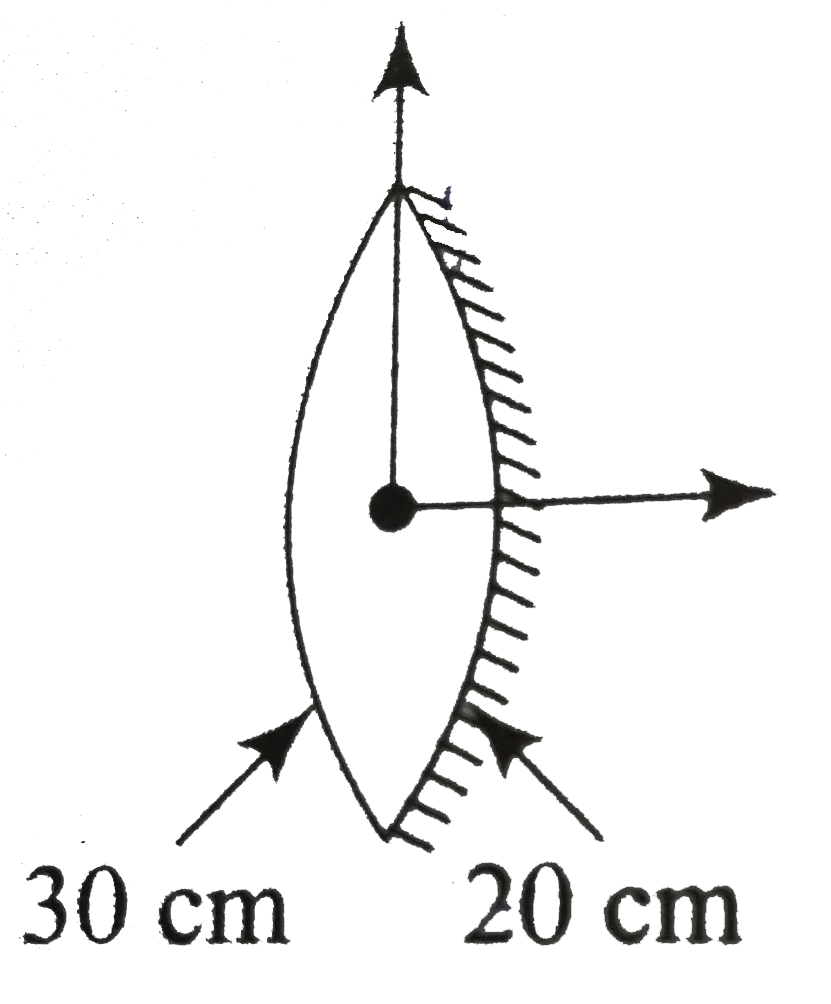Two plano-concave lenses of glass of refractive index 1.5 have radii of curvature of 20 and 30 cm. They are placed in contact with curved surface towards each other and the space between them is filled with a liquid of refractive index 43, find the focal length of the system.
To find the focal length of the system consisting of two plano-concave lenses in contact with each other and filled with a liquid, we can follow these steps:
1. Identify the Parameters:
- Refractive index of glass, μg=1.5
- Radii of curvature:
- For the first lens, R1=+∞ (plano surface)
- For the second lens, R2=−20 cm (concave surface)
- For the second lens:
- R3=−30 cm (concave surface)
- R4=+∞ (plano surface)
- Refractive index of the liquid, μl=43
2. Calculate Focal Length of the First Lens (in glass):
Using the lens maker's formula:
1f1=(μg−1)(1R1−1R2)
Substituting the values:
1f1=(1.5−1)(1∞−1−20)=0.5(0+120)=0.520=140
Therefore, f1=40 cm.
3. Calculate Focal Length of the Second Lens (in liquid):
Using the lens maker's formula again:
1f2=(μl−1)(1R3−1R4)
Substituting the values:
1f2=(43−1)(1−30−1∞)=13(−130)=−190
Therefore, f2=−90 cm.
4. Calculate Focal Length of the System:
The total focal length f of the system is given by:
1f=1f1+1f2
Substituting the values:
1f=140−190
To find a common denominator (which is 360):
1f=9360−4360=5360
Therefore, f=3605=72 cm.
5. Determine the Sign of the Focal Length:
Since the focal length is positive, the system behaves as a converging lens.
Final Answer:
The focal length of the system is f=72 cm.
- Refractive index of glass, μg=1.5
- Radii of curvature:
- For the first lens, R1=+∞ (plano surface)
- For the second lens, R2=−20 cm (concave surface)
- For the second lens:
- R3=−30 cm (concave surface)
- R4=+∞ (plano surface)
- Refractive index of the liquid, μl=43
Using the lens maker's formula:
1f1=(μg−1)(1R1−1R2)
Substituting the values:
1f1=(1.5−1)(1∞−1−20)=0.5(0+120)=0.520=140
Therefore, f1=40 cm.
Using the lens maker's formula again:
1f2=(μl−1)(1R3−1R4)
Substituting the values:
1f2=(43−1)(1−30−1∞)=13(−130)=−190
Therefore, f2=−90 cm.
The total focal length f of the system is given by:
1f=1f1+1f2
Substituting the values:
1f=140−190
To find a common denominator (which is 360):
1f=9360−4360=5360
Therefore, f=3605=72 cm.
Since the focal length is positive, the system behaves as a converging lens.
The focal length of the system is f=72 cm.
Topper's Solved these Questions
- BOOK - VMC MODULES ENGLISHCHAPTER - RAY OPTICS EXERCISE - Example21videos
RAY OPTICS
- BOOK - VMC MODULES ENGLISHCHAPTER - RAY OPTICS EXERCISE - PRACTICE EXERCISE-11videos
RAY OPTICS
- BOOK - VMC MODULES ENGLISHCHAPTER - QUIZEXERCISE - PHYSICS30videos
QUIZ
- BOOK - VMC MODULES ENGLISHCHAPTER - RAY OPTICS AND WAVE OPTICS EXERCISE - IMPECCABLE58videos
RAY OPTICS AND WAVE OPTICS
Similar Questions
Two plano-concave lenses of glass of refractive 1.5 have radii of curvature of 20 and 30 cm. They are placed in contact with curved surface towards each other and the space between yhem is filled with a liquid of refractive index 2/3. Find the focal length of the system.
View SolutionTwo plano concave lenses of glass of refractive index 1.5 have radii of curvature 20 cm and 30 cm respectively. They are placed in contact with the curved surface towards each other and the space between them is filled with a liquid of refractive index 5/2. The focal length of the combination is (in cm)
View SolutionA plano convex lens is made of glass of refractive index 1.5. The radius of curvature of its convex surface is R. Its focal length is
View SolutionTwo identical thin planoconvex glass lenses (refractive index 1.5) each having radius of curvature of 20cm are placed with their convex surfaces in contact at the centre. The intervening space is filled with oil of refractive index 1.7. The focal length of the combination is
View SolutionA plano-concave lens is made of glass of refractive index 1.5 and the radius of curvature of its curved face is 100 cm. What is the power of the lens?
View SolutionTwo identical thin planoconvex glass lenses (refractive index 1.5) each having radius of curvature of 20 cm are placed with their convex sufaces in contact at the centre. The intervening space is filled with oil of refractive index 1.7 The focal length of the combination is
View SolutionA plano-convex lens has refractive index 1.6 and radius of curvature 60 cm. What is the focal length of the lens?
View SolutionTwo concave lenses L1andL2 are kept in contact with each other. If the space between the two lenses is filled with a material of smaller refractive index, the magnitude of the focal length of the combination
View SolutionA concavo-convex lens is made of glass of refractive index 1.5. The radii of curvature of its two surfaces are 30cm and 50cm. Its focal length when placed in a liquid of refractive index 1.4 is
View SolutionA biconvex lens is made of glass with refractive index 1.5 and has radii of curvature 20 cm and 30 cm. If the 20 cm surface is silvered, what is the effective focal length of the mirror formed?
 View Solution
View Solution

